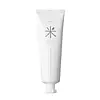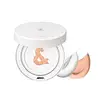What's inside
What's inside
 Key Ingredients
Key Ingredients

 Benefits
Benefits

 Concerns
Concerns

 Ingredients Side-by-side
Ingredients Side-by-side

Water
Skin ConditioningPropanediol
SolventButylene Glycol
HumectantGlycerin
HumectantDimethicone
EmollientNiacinamide
SmoothingCI 77891
Cosmetic ColorantCyclopentasiloxane
Emollient1,2-Hexanediol
Skin ConditioningPentylene Glycol
Skin ConditioningBoron Nitride
AbsorbentSodium Acrylate/Sodium Acryloyldimethyl Taurate Copolymer
Emulsion StabilisingSilica
AbrasiveIsohexadecane
EmollientHydroxyethyl Acrylate/Sodium Acryloyldimethyl Taurate Copolymer
Emulsion StabilisingDimethiconol
EmollientPolysorbate 80
EmulsifyingCitrus Aurantium Bergamia Fruit Oil
MaskingEthylhexylglycerin
Skin ConditioningSorbitan Oleate
EmulsifyingXanthan Gum
EmulsifyingTriethoxycaprylylsilane
Adenosine
Skin ConditioningDisodium EDTA
Citrus Limon Peel Oil
MaskingLavandula Angustifolia Oil
MaskingCananga Odorata Flower Oil
MaskingCitrus Aurantium Dulcis Peel Oil
MaskingEucalyptus Globulus Leaf Extract
PerfumingOryza Sativa Extract
AbsorbentWater, Propanediol, Butylene Glycol, Glycerin, Dimethicone, Niacinamide, CI 77891, Cyclopentasiloxane, 1,2-Hexanediol, Pentylene Glycol, Boron Nitride, Sodium Acrylate/Sodium Acryloyldimethyl Taurate Copolymer, Silica, Isohexadecane, Hydroxyethyl Acrylate/Sodium Acryloyldimethyl Taurate Copolymer, Dimethiconol, Polysorbate 80, Citrus Aurantium Bergamia Fruit Oil, Ethylhexylglycerin, Sorbitan Oleate, Xanthan Gum, Triethoxycaprylylsilane, Adenosine, Disodium EDTA, Citrus Limon Peel Oil, Lavandula Angustifolia Oil, Cananga Odorata Flower Oil, Citrus Aurantium Dulcis Peel Oil, Eucalyptus Globulus Leaf Extract, Oryza Sativa Extract
Water
Skin ConditioningZinc Oxide
Cosmetic ColorantPropylheptyl Caprylate
EmollientButyloctyl Salicylate
Skin ConditioningCI 77891
Cosmetic ColorantC12-15 Alkyl Benzoate
AntimicrobialMethyl Trimethicone
Skin ConditioningAcrylates Copolymer
Caprylyl Methicone
Skin ConditioningCaprylyl Trimethicone
Skin ConditioningButylene Glycol
HumectantMethyl Methacrylate Crosspolymer
Polymethyl Methacrylate
Lauryl Polyglyceryl-3 Polydimethylsiloxyethyl Dimethicone
Skin ConditioningTriethoxycaprylylsilane
1,2-Hexanediol
Skin ConditioningBisabolol
MaskingAluminum Hydroxide
EmollientSilica
AbrasivePolyglyceryl-4 Oleate
EmulsifyingGlycerin
HumectantHydroxyacetophenone
AntioxidantMagnesium Sulfate
Stearic Acid
CleansingPolyglyceryl-6 Polyhydroxystearate
EmulsifyingPolyglyceryl-6 Polyricinoleate
EmulsifyingChlorella Vulgaris Extract
Skin ConditioningGlucose
HumectantParfum
MaskingPolyglyceryl-3 Polyricinoleate
EmulsifyingFructooligosaccharides
HumectantFructose
HumectantVinyl Dimethicone/Methicone Silsesquioxane Crosspolymer
Adenosine
Skin ConditioningPolyglycerin-6
HumectantOryza Sativa Extract
AbsorbentCI 77492
Cosmetic ColorantIsododecane
EmollientOctyldodecanol
EmollientTocopherol
AntioxidantCI 77491
Cosmetic ColorantPolyglyceryl-4 Isostearate
EmulsifyingEthylhexylglycerin
Skin ConditioningIsopropyl Titanium Triisostearate
EmollientAscorbyl Palmitate
AntioxidantWater, Zinc Oxide, Propylheptyl Caprylate, Butyloctyl Salicylate, CI 77891, C12-15 Alkyl Benzoate, Methyl Trimethicone, Acrylates Copolymer, Caprylyl Methicone, Caprylyl Trimethicone, Butylene Glycol, Methyl Methacrylate Crosspolymer, Polymethyl Methacrylate, Lauryl Polyglyceryl-3 Polydimethylsiloxyethyl Dimethicone, Triethoxycaprylylsilane, 1,2-Hexanediol, Bisabolol, Aluminum Hydroxide, Silica, Polyglyceryl-4 Oleate, Glycerin, Hydroxyacetophenone, Magnesium Sulfate, Stearic Acid, Polyglyceryl-6 Polyhydroxystearate, Polyglyceryl-6 Polyricinoleate, Chlorella Vulgaris Extract, Glucose, Parfum, Polyglyceryl-3 Polyricinoleate, Fructooligosaccharides, Fructose, Vinyl Dimethicone/Methicone Silsesquioxane Crosspolymer, Adenosine, Polyglycerin-6, Oryza Sativa Extract, CI 77492, Isododecane, Octyldodecanol, Tocopherol, CI 77491, Polyglyceryl-4 Isostearate, Ethylhexylglycerin, Isopropyl Titanium Triisostearate, Ascorbyl Palmitate
 Reviews
Reviews

Ingredients Explained
These ingredients are found in both products.
Ingredients higher up in an ingredient list are typically present in a larger amount.
1,2-Hexanediol is a synthetic liquid and another multi-functional powerhouse.
It is a:
- Humectant, drawing moisture into the skin
- Emollient, helping to soften skin
- Solvent, dispersing and stabilizing formulas
- Preservative booster, enhancing the antimicrobial activity of other preservatives
Adenosine is in every living organism. It is one of four components in nucleic acids that helps store our DNA.
Adenosine has many benefits when used. These benefits include hydrating the skin, smoothing skin, and reducing wrinkles. Once applied, adenosine increases collagen production. It also helps with improving firmness and tissue repair.
Studies have found adenosine may also help with wound healing.
In skincare products, Adenosine is usually derived from yeast.
Learn more about AdenosineButylene Glycol (or BG) is used within cosmetic products for a few different reasons:
Overall, Butylene Glycol is a safe and well-rounded ingredient that works well with other ingredients.
Though this ingredient works well with most skin types, some people with sensitive skin may experience a reaction such as allergic rashes, closed comedones, or itchiness.
Learn more about Butylene GlycolCi 77891 is a white pigment from Titanium dioxide. It is naturally found in minerals such as rutile and ilmenite.
It's main function is to add a white color to cosmetics. It can also be mixed with other colors to create different shades.
Ci 77891 is commonly found in sunscreens due to its ability to block UV rays.
Learn more about CI 77891Ethylhexylglycerin (we can't pronounce this either) is commonly used as a preservative and skin softener. It is derived from glyceryl.
You might see Ethylhexylglycerin often paired with other preservatives such as phenoxyethanol. Ethylhexylglycerin has been found to increase the effectiveness of these other preservatives.
Glycerin is already naturally found in your skin. It helps moisturize and protect your skin.
A study from 2016 found glycerin to be more effective as a humectant than AHAs and hyaluronic acid.
As a humectant, it helps the skin stay hydrated by pulling moisture to your skin. The low molecular weight of glycerin allows it to pull moisture into the deeper layers of your skin.
Hydrated skin improves your skin barrier; Your skin barrier helps protect against irritants and bacteria.
Glycerin has also been found to have antimicrobial and antiviral properties. Due to these properties, glycerin is often used in wound and burn treatments.
In cosmetics, glycerin is usually derived from plants such as soybean or palm. However, it can also be sourced from animals, such as tallow or animal fat.
This ingredient is organic, colorless, odorless, and non-toxic.
Glycerin is the name for this ingredient in American English. British English uses Glycerol/Glycerine.
Learn more about GlycerinOryza Sativa Extract comes from the rice grain, Oryza sativa. Rice extract has wound healing, antioxidant, anti-inflammatory, and hydrating properties.
Rice grains contain numerous antioxidants which may help with anti-aging, such as vitamin E. Antioxidants help stabilize free-radical molecules. Unstable free-radical molecules may damage your skin cells and accelerate signs of aging.
A study from 2002 found rice to help increase the rate of wound healing. The same study found an improvement of skin barrier function in the patients after taking rice baths.
Numerous in-vitro studies have found rice water to help decrease sun damage by increasing collagen production and inhibiting the process of tyrosinase.
Long story short- tyrosinase is an enzyme that controls melanin production. Our bodies start producing melanin (AKA tanning) when exposed to UV radiation to protect against damage. Rice water is found to partially block this process.
Though more research is needed on rice's ability to help with UV protection, recent studies seem promising.
Wondering why rice is hydrating? The protein in rice have emollient properties. Emollients create a barrier on the skin to trap moisture in, keeping your skin moisturized.
Some rice extract may have mildly-exfoliating properties. These are mainly limited to Oryza Sativa (Rice) Bran and Oryza Sativa (Rice) Germ Powder.
This rice was first cultivated in China over 10,000 years ago. Many cultures throughout Asia have used rice water on skin and hair for centuries.
Learn more about Oryza Sativa ExtractSilica, also known as silicon dioxide, is a naturally occurring mineral. It is used as a fine, spherical, and porous powder in cosmetics.
Though it has exfoliant properties, the function of silica varies depending on the product.
The unique structure of silica enhances the spreadability and adds smoothness, making it a great texture enhancer.
It is also used as an active carrier, emulsifier, and mattifier due to its ability to absorb excess oil.
In some products, tiny microneedles called spicules are made from silica or hydrolyzed sponge. When you rub them in, they lightly polish away dead skin layers and enhance the penetration of active ingredients.
Learn more about SilicaTriethoxycaprylylsilane is a silicone used to bind and stabilize ingredients.
As an emulsifier, it helps prevent ingredients from separating. This can help elongate the shelf life of products.
Triethoxycaprylylsilane is often used to coat mineral sunscreens ingredients to help give a better feel. It also helps reduce oxidative stress in sunscreens.
Learn more about TriethoxycaprylylsilaneWater. It's the most common cosmetic ingredient of all. You'll usually see it at the top of ingredient lists, meaning that it makes up the largest part of the product.
So why is it so popular? Water most often acts as a solvent - this means that it helps dissolve other ingredients into the formulation.
You'll also recognize water as that liquid we all need to stay alive. If you see this, drink a glass of water. Stay hydrated!
Learn more about Water